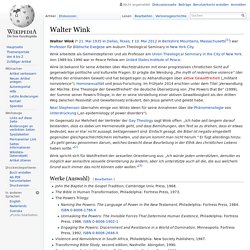

Walter Wink. Walter Wink (* 21.

Mai 1935 in Dallas, Texas; † 10. Mai 2012 in Berkshire Mountains, Massachusetts[1]) war Professor für Biblische Exegese am Auburn Theological Seminary in New York City. Wink arbeitete als Gemeindepfarrer und als Professor am Union Theological Seminary in the City of New York. Von 1989 bis 1990 war er Peace Fellow am United States Institute of Peace. Wink ist bekannt für seine Arbeiten über Machtstrukturen mit einer progressiven christlichen Sicht auf gegenwärtige politische und kulturelle Fragen. Neal Stephenson übernahm einige von Winks Ideen für seine Annahmen über die Phänomenologie von Unterdrückung („an epidemiology of power disorders“).
Im Gegensatz zur Mehrheit der Vertreter der Gay Theology sagt Wink offen: „Ich habe seit langem darauf bestanden, dass es dabei um Hermeneutik geht, und dass Bemühungen, den Text so zu drehen, dass er etwas bedeutet, was er klar nicht aussagt, beklagenswert sind. Werke (Auswahl)[Bearbeiten] Weblinks[Bearbeiten] Quellen[Bearbeiten] Making Life Work. For You. For Everyone. No Exceptions. In this 6-month, 3-part telecourse, Miki Kashtan shows with astonishing clarity how, with dedication to practice and support from others, you can begin to participate in creating the world so many of us long for, a world that honors and seeks to meet the needs of everyone, that welcomes each person’s truth, that rests on faith that solutions can be found to the most challenging problems facing us, individually and collectively.

Your participation starts with your willingness to risk opening to yourself in a new way: to your deepest longings, to the hearts of those who are frighteningly “other,” to the uncertainty of life without the absolutes of “right” and “wrong,” “good” and “bad.” The more people who join you in taking the first step, the nearer this world becomes. If you can say “yes” to any of the points below, then this course is definitely for you: Fridays, May 24 and 31, June 14 and 28 12:00-2:00pm PDT - My Time Zone? This class’s carefully designed practices are aimed at: Hamburg course - Compassionate Communication Hamburg. With the help of Nonviolent Communication (NVC) we’re going to learn to come closer to ourselves, listening carefully to what we’re thinking, feeling and needing.

First we connect with the first layer, the way we’ve been educated to think: what’s right and wrong with the others/with ourselves, what we think we deserve, how we should behave in society, in family… This is where most of the violence on our planet comes from: a way of thinking made to obey authority – a language that tries to change other people using punishments, blame, guilt, shame or rewards.
When caught up with becoming either the winner or the loser, it’s very challenging to experience compassion and feel happy. Connecting with this way of thinking is essential to get deeper into a more intimate space: the need space. This is a very personal quest, and for me the most important thing of my life. This course is designed to help you in finding yours. Registration and questions: contact me.
BYIO - Remembering Marshall's Dream. Célébration de la vie de Marshall Rosenberg (1ere partie) How to Practice Nonviolent Communication: 4 Steps. Reader Approved Three Methods:Practicing NVCHandling BoundariesCommunicating WellCommunity Q&A Nonviolent Communication (NVC)[1] includes a simple method for clear, empathic communication, consisting of four areas of focus: ObservationsFeelingsNeedsRequests NVC aims to find a way for all present to get what really matters to them without the use of guilt, humiliation, shame, blame, coercion, or threats.

It is useful for resolving conflicts, connecting with others, and living in a way that is conscious, present, and attuned to the genuine, living needs of yourself and others. Steps Practicing NVC 1State the observations that are leading you to feel the need to say something. Handling Boundaries Nonviolent Communication is an idealized style of communication, and it will not work in every single situation. 1Make sure a person is open to nonviolent communication. Communicating Well 1Decide upon the solution together, if possible.
Community Q&A Ask a Question Sentence templates Video. The Basics of Non Violent Communication DVD 1 Part 2. Übung - Bedürfnissprache entwickeln - Marshall Rosenberg (dt. Untertitel) Marshall Rosenberg NVC Role Play. Nonviolent Communication - San Francisco Lecture / Workshop - Marshall Rosenberg - CNVC.org. Nonviolent Communication Training Course - Marshall Rosenberg - Session 2 - CNVC.org. Self-empathy exercise NVC Nonviolent Communication. Liebst du mich? - Rollenspiel Wolf und Giraffe - Marshall B. Rosenberg - dt. Untertitel. Nonviolent Communication (NVC) in Action (Part 3) Nonviolent Communication (NVC) in Action (Part 1)